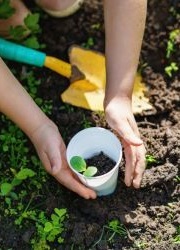How To Create Natural Play Environments For Young Kids
Kids spend twice as much time indoors as their parents do. But even when kids go outside to play, most have access to traditional playing space that comprises a traditional swing, slide, and a couple of climbing structures.
Playing in traditional playgrounds isn’t necessarily negative; it won’t boost a kid’s imagination, activeness, creativity, and problem-solving skills or make them want to play outside longer.
And this is where natural playgrounds come in, to help engage younger children. Having natural play environments will help kids reconnect with the great outdoors. The beauty of natural play environments is that they are easy and affordable to create. Even with limited space, natural play environments allow kids to find ways of engaging with whatever natural materials they are provided.
Before creating a natural playing environment for your kid, consider checking out a nature based playground, focusing on all the benefits it offers young kids. Next, create a positive attitude towards dirt by finding solutions to ensure your kids won’t bring dirt back into the house.
So, if you are looking to encourage outdoor exploration, discussed below are some key elements that will guide you in creating a natural play environment that is safe and fun. Happy reading!
Consider Creating A Sensory Garden
One main component of consideration when setting up a natural play environment has to be your kid’s five senses. Nature is filled with different opportunities for kids to use their senses. Creating a sensory garden will draw your kid’s attention to all that grows around them.
And since sensory gardens are to be explored through taste, smell, sight, touch, and hearing, the following are great ways of awakening those senses.
- Sound– nature has different exciting sounds from birds, animals, and the swaying of trees on a windy day. However, if your backyard isn’t close to nature, consider adding things such as wind chimes. Additionally, consider making instruments with a rhythm that can be played outside.
- Smell– plant different greenery and flowers that’ll produce pleasant smells. Young kids like to take time to smell all the scents around them.
- Touch– when it comes to touch, there are different options available around you. For instance, dirt is a great way of allowing kids to explore nature. You can set up a mud bucket or have a wheelbarrow for kids to push around.
Another great way of feeding your kid’s sense of touch is by creating a sandbox allowing them to build and dig around to their heart’s content. Expand the textures by getting sticks for the play space. Sticks offer versatility; kids can use their imagination to create endless possibilities. Most kids use sticks to build, write, draw, stack, or sort them into sizes and types.
- Sight– if you love flowers, your kids also enjoy looking at flowers. All the different colors and sizes of flowers offer fun ways for kids to learn about them.
- Taste– having a garden gives kids a great chance to engage with nature while still getting healthy food. Some great plants to incorporate in natural play environments include thornless berries, snap peas, beans, strawberries, etc.
Provide Safe Access To Water
Given the opportunity, kids will play with water all day long. As a result, consider providing safe access to water by adding a water source to your space. However, note that you’ll need to supervise your kid anytime they are around water.
Consider encouraging kids to pour the water on the ground, watch it flow, water the plants in the garden, mix it with soil, splash in it, or explore in any other safe way. But when allowing your child to enjoy the water, set your limit and teach them to be respectful of the source of their fun by not being wasteful.
Add Real Tools
Creating a natural play environment comes with encouraging kids to garden. So, when gardening, provide lightweight and safe tools for young kids. You can easily find miniature tools fit for young kids. For instance, you can get a small rake and broom that’s short and manageable that kids can use to help with yard work.
Set Aside Quiet Spaces
With everything to do, young kids get tired and might need time off. As a result, you need to create a space where kids can be still and rest. One great way is by adding a shelter that expands the possibilities. A wooden play house or bean teepee is among the best choices.
Inside the home, ensure there is a place for kids to do arts and crafts with all the resources available. Your child may like to draw or paint. And let’s not forget that about the long winter months when play outside is limited.
Whichever option you settle, make sure the space is quiet without distractions and suitable for resting the body and mind. That’s a vital element in every natural play environment.
Here’s a quick video showing a good example of a natural play environment:
Bottom Line
You don’t have to stress about the space if you want to create a natural play environment for your young kids. Any space can hold great opportunities for your child to have memorable childhood experiences. Using the elements discussed above will make your kids enjoy playing in any natural environment.





 Explore the Safe Search Engine -
Explore the Safe Search Engine -